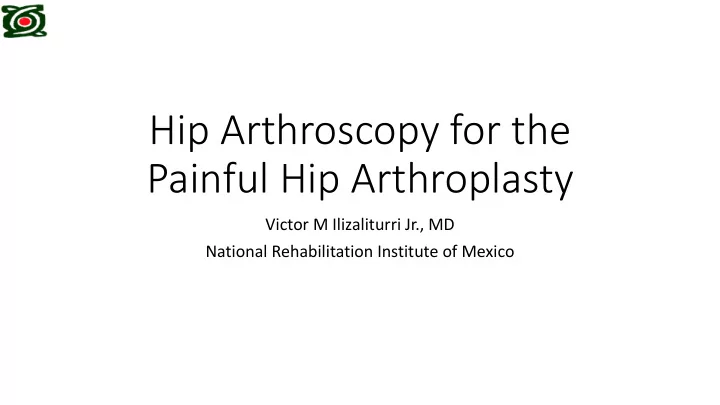

Hip Arthroscopy for the Painful Hip Arthroplasty Victor M Ilizaliturri Jr., MD National Rehabilitation Institute of Mexico
Disclosure • Victor M. Ilizaliturri Jr. MD. – Consulting income from: – Conmed-Linvatec – DePuy Synthes – Zimmer Biomet – Research support from: – Conmed-Linvatec. – DePuy Synthes.
Introduction • Up to 4.3% of the patients with anterior hip pain after THR may be due to iliopsoas impingement. • Posterior hip pain must study offset reconstruction, HO, probable isquiofemoral impingement. • Iliopsoas impingement after THR constitutes a differential diagnosis. • Cup must be stable. • Infection must be ruled out. • MARS MR and/or Ion level analysis. • Metal on metal ion levels. • Taper corrosion. Dora, JBJS, Br, 2007
Diagnosis • Persistent anterior hip pain after THR. • Tenderness in groin. • Pain in activities that require hip flexion. • Climb stairs. • Exit a car. • Pain relief after US guided injections.
US Guided Iliopsoas Injection
Imaging • AP Pelvis View. • Lateral acetabular view. Chalmers, JBJS, 2017
Imaging • CT Dora, JBJS, Br, 2007
Treatment • Dora et al. JBJS Br 2007. • Psoas impingement after THR, conservative vs cup revision vs open tenotomy • 29 patients, 30 hips. • 8 conservative treatment (All failed no symptom improvement one cup revision) mean F/U 41 months. • 22 operative treatment. • Revision 14. High incidence of complications, 1 trochanteric non-union, 1 anterior dislocation, 1 superficial infection, 5 troch bursitis, 1 unexplained neuropathic pain, multiple revisions and deep infection (resection arthroplasty). • Tenotomy 6. All patients improved at three months, one patient presented HO and symptom recurrence after 18 months. Mean f/U 36 months.
Treatment
Treatment • Dora et al, JBJS Br 2007.
Treatment • Jerosch, Arch Orthop Trauma Surg, 2013. • Psoas impingement after THR. • 35 patients, supine endoscopic release, anterior capsulotomy, traction. • 12 resurfacing, 11 screw in uncemented cups and 12 uncemented pressfit cup. • 15 cases secondary to DDH. • 3 cases protrusion of the anterior cup was only identified at arthroscopy.
Treatment • 32 of 35 patients presented immediate pain relief after endoscopic release of the iliopsoas. • One patient had pain relief at 6 weeks and one remained symptomatic but referred improvement over preoperative status
Treatment • Batailler el al, Orthopaedics & Traumatology: Surgery & Research (in press). • Cup revision for iliopsoas impingement after THR. • Multicentre retrospective study (10 surgeons, 4 centres), 46 patients. • Anterior cup un-coverage at foux profile and CT. • 11 had also release of the iliopsoas because of tendon injury or protrusion of the new cup (lack of anterior wall).
Treatment • Mean hospital stay after cup revision 6 nights (4-15). • 40 patients full weight bearing, 6 toe touch because of suboptimal stability of new cup. • Mean F/U 21 months (6 months to 6 years). • 39 were satisfied at last F/U with significant improvement of Oxford Hip Score. • 4 Failures because of recurrent pain. • 1 full improvement after endoscopic iliopsoas release at lesser trochanter. • Other 3 accepted to live with slight pain. • Complications in 3 patients. • 1 deep vain thrombosis, 1 anterior dislocation (revised through anterior approach) and 1 deep infection (2 stage revision).
Treatment • Chalmers et al, JBJS 2017. • Retrospective analysis of patients with diagnosis of painful THR due to iliopsoas impingement (hemispherical uncemented cup and PE bearing). • 49 patients included, 21 cup revision, 8 tenotomies and 20 non operative. Mean F/U 4 years. • Measurements of acetabular prominence was done in true lateral x rays. • 10 patients were successful in non operative group (50%). • With les than 8mm anterior cup prominence tenotomy was successful in 5 of 5 patients. • More than 8mm anterior cup prominence cup revision was successful in 12 of 13 patients and tenotomy in one of 3 patients.
Treatment Chalmers, JBJS, 2017
My approach • Release at the lesser trochanter. • Access portals for iliopsoas bursa. • No traction, lateral position. • No implant assessment. • Fluoro navigation to lesser trochanter. • RF retrograde release at lesser trochanter.
Treatment, Iliopsoas Release • Protruding cup anteriorly (<8mm). • Lateralized cup. • Large cup. • Slight retroversion without instability. • No metal on metal implant.
Treatment Acetabular Revision. • Grossly malposition of implant. • Protruding more than 8mm. • DDH (anterior wall deficient). • Very large or very lateralized). • Retroverted. • Implant impingement. • Dislocation. • Metal on metal implants increased ion levels or poor track record.
Treatment • Iliopsoas impingement with anterior uncemented cup prtrusion. • 1 mal positioned ring. • Endoscopic release at lesser trochanter. • 16 patients. • 1 failure.
Summary • Psoas impingement is a differential diagnosis. • Anterior hip pain after THR. • Not loose not infected. • US guided injections. • Focal anterior protrusion of less than 8mm maybe a good option for iliopsoas release. • Endoscopic release is a great option (lesser trochanter). • Grossly mal-positioned implants require cup revision. • Cup revision has more morbidity than tenotomy.
Gracias vichip2002@yahoo.com.mx
Recommend
More recommend